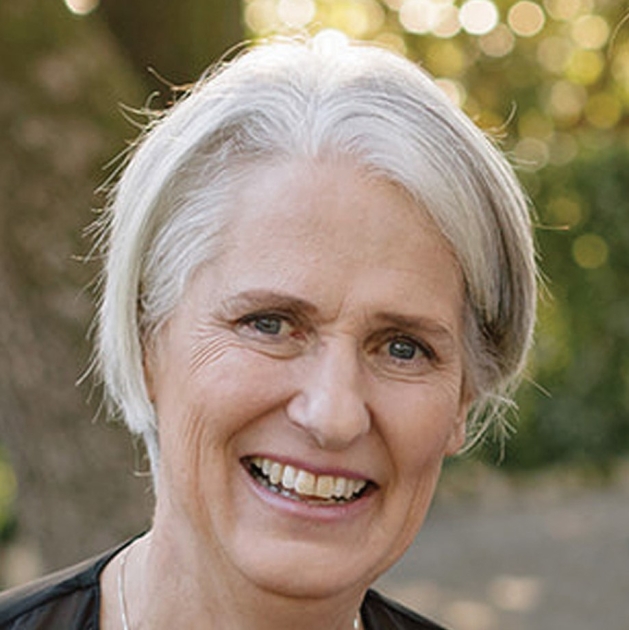
In tennis, there is a point at which the momentum of the game swings. A player receiving service is one point away from a win, with the opportunity to turn the tide of the match by winning the server’s game. It’s a defining moment, a crossroads that can change the course of the match and set. This is the break point.
“It really fit,” says Minnetonka resident Sheri Brenden of the title of her debut book, Break Point: Two Minnesota Athletes and the Road to Title IX. “It just felt like it gave a sense of what the book was.”
Though the former research librarian began writing this book in 2005, it has been in the works for a lifetime—or at least since a young Sheri watched her older sister, Peggy Brenden, file a lawsuit in 1972, so she could play tennis with the boys at St. Cloud Tech High School.
 Peggy Brenden playing tennis. (Photo was originally printed in her school newspaper.)
Peggy Brenden playing tennis. (Photo was originally printed in her school newspaper.)
Break Point dives into Peggy’s journey—and that of Hopkins track and cross-country runner Toni St. Pierre—as they pushed the gender barriers that kept girls and women off the playing field. The book recounts the circumstances around the landmark case Brenden v. Independent School District 742 as it made its way through the courts and became the first case ever to reference Title IX. The decision of Judge Miles Lord was upheld in the Eighth Court of Appeals, setting a precedent that, in tandem with Title IX, would pave the way for generations of student athletes.
 Toni St. Pierre as she appears in her Eisenhower High School yearbook in 1973.
Toni St. Pierre as she appears in her Eisenhower High School yearbook in 1973.
“Like many girls in athletics, [the case] was glossed over in a lot of ways,” Sheri says. “Women are powerful athletes, and they are part of our history. These kinds of stories are what give all of us inspiration to continue in that.”
University of Minnesota Press associate editor Kristian Tvedten commends Sheri’s “considerable skills” as a storyteller and researcher, describing the book as “a story that is as timely today as it was in 1972.”
While Break Point relies on extensive research on the legal case, newspaper coverage and interviews with key players, it’s the author’s connection with her subject that makes all the difference—turning what could be a technical recounting of a legal case into a story that touches on what it felt like for the individuals involved—before, during and after.
“Being her sister, it gave me a certain empathy—also because it’s part my history, too,” Sheri says. Though Sheri is five years Peggy’s junior, she recalls the lawsuit in broad strokes, as a period that her family lived through but that she viewed then simply as “Peg’s lawsuit.” Yet, by the time Sheri stepped onto her high school campus, much had already changed.
“[The case] just created this kind of mindset for me that nobody could tell me that I couldn’t be playing a sport, that I didn’t belong on the field or on a court,” Sheri says. “By the time I got into high school, there were all kinds of sports for girls, and I was certain that I was ready to try most any of them because I didn’t think there was any reason why I shouldn’t.”
Sheri speaks about her sister’s story with pride, remarking on the role sports and law played in Peggy’s life (She went on to become an attorney, then judge and has never stopped playing tennis.) and that of St. Pierre, who, after a remarkable athletic journey throughout school, worked as an obstetrical nurse and later took up triathlons and marathons before her passing in 2013.
“Fifty years has changed a lot of the way men and women, girls and boys look at the world and how they interact,” Sheri says. “It’s hard for us—even now, even having lived it—to recall all the taboos and gender rigidity there was that we
just had to take a status quo.”
In the five decades since Title IX, the NCAA has reported a steady increase in participation of women in sports across the board, especially within racially and ethnically diverse groups, but a gap remains to be filled, especially in leadership positions in the sports world.
“Over the last 50 years, we have accomplished so much for women in sports, but we must continue to forge ahead and never forget what the women before us accomplished,” says Meghan Potter, Wayzata High School director of athletics and activities. “We still have trails to blaze allowing for equality across the board in all forms. We need more women athletic directors and coaches, too, as I firmly believe our young women should have strong female role models teaching them how to be not only successful athletes, but successful citizens, as well.”
Though Sheri observed that change “happened suddenly” across America following the passing of Title IX, “But we haven’t achieved equity yet,” she says, adding, “We all need to think hard about the boxes we’ve put women in for a long time about who they’re supposed to be. We’ve let them become athletes, but now we need to also say, ‘Well, how can we nurture that with the same resources we do for boys?’”
 Break Point, released by University of Minnesota Press, is available for purchase online at upress.umn.edu and at select local booksellers. (Find a full list at sheribrenden.com.)
Break Point, released by University of Minnesota Press, is available for purchase online at upress.umn.edu and at select local booksellers. (Find a full list at sheribrenden.com.)
Title IX of the Education Amendments of 1972
“No person in the United States shall, on the basis of sex, be excluded from participation in, be denied the benefits of, or be subjected to discrimination under any educational program or activity receiving Federal financial assistance.”
Wayzata High School Director of Athletics and Activities Weighs In
“As a female athletic director, former collegiate athlete, three-sport high school athlete, I am forever indebted to the Title IX pioneers who fought for equality in women’s sports. Because of these brave women, I am able to honor their legacy and set new trails of my own for all of the young women who are now able to play the sports they love without having to think about ever having the inability to play sports in the same way as the boys.
“As a female [athletic director] at the largest high school in Minnesota, I believe it is extremely important to ensure all sports are treated equally. Wayzata must lead by example, and we are doing that with an all-female office staff. Barb Beise, assistant [athletic director], has been an amazing influence on our female athletes and has always been a strong advocate for sports equality. Having been at [Wayzata High School] for 26 years, she’s seen Wayzata through various highs and lows and through it all has been
a guiding light for our young women here.” —Meghan Potter, director of athletics and activities, Wayzata High School
By the Numbers
Numbers can speak volumes. Consider the following information, according to the Women’s Sports Foundation.
Two out of five girls play sports today, which is a change from one in 27 before Title IX.
Since 1972, girls’ participation in high school sports has increased 12 times.
The margin in athletic scholarships offered to women versus men is $252 million.
The number of additional high school sports opportunities available to girls now versus prior to Title IX is three million.
The number of additional college sports opportunities available to men versus women is 60,000.
For the 2020-2021 academic year, 41 percent of women’s NCAA teams had women head coaches.
Of athletic directors, four percent are BIPOC women, and 20 percent are white women.
Learn more at womenssportsfoundation.org.









